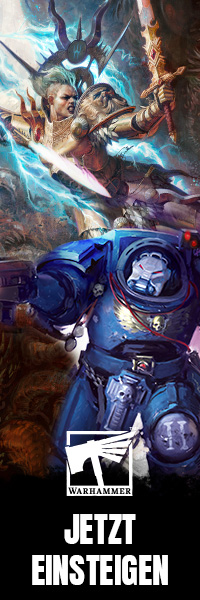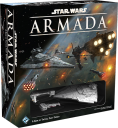Star Wars Armada: Raumjäger
In einer neuen Preview für Star Wars Armada kommen die kleinen Raumjäger in den Fokus und welche Rolle sie neben den großen Raumschiffen spielen.
“The Empire doesn’t consider a small one-man fighter to be any threat, or they’d have a tighter defense. An analysis of the plans provided by Princess Leia has demonstrated a weakness in the battle station.”
–General Jan DodonnaThere’s no denying the raw power of the Star Wars galaxy’s capital ships. Many of them are massive war machines that can exceed a kilometer in length, their crews can number in the thousands, and the largest of them boast enough firepower to cower entire star systems. Still, the Star Wars movies remind us that there’s always room – even a need – for personal heroics. There’s always the chance that a single starfighter pilot can turn the tide of battle.
Accordingly, even though they’re dwarfed by the capital ships they accompany, starfighters and their pilots play a critical part in the tactical fleet battles of Star Wars™: Armada.
In our earlier previews, we focused primarily on the game’s capital ships. We looked at how their command values and command stacks force you to plan ahead, we looked at how capital ships battle, and we looked at how they fly along the table. Today, though, we turn our attention to the game’s starfighters, looking at the how they function within the game and looking, also, at how even a single starfighter squadron can turn the tide of battle.
The Squadron Phase
Squadrons move according to a set of rules that is entirely different than that utilized by the game’s capital ships, and though their attacks work similarly, they use the distance side of the game’s range ruler, rather than the range side. The differences between squadrons and ships are further reinforced by the fact that squadrons also have their own phase within the game. After you and your opponent have activated all of your capital ships in the Ship Phase, you proceed to the Squadron Phase.
In the Squadron Phase, you and your opponent take turns activating any squadrons that were not already activated by a Squadron command during the Ship Phase. Each squadron that activates during this phase may either move or attack, but cannot do both.
The player who has initiative goes first. He chooses one of his unactivated squadrons and activates it:
If he chooses to move his squadron, he utilizes the range ruler, placing it on the table so that its distance side is faceup, with the distance “1” end of the ruler touching any part of the base of his squadron. Then, he picks up the squadron and places it at any point along the ruler, so long as its base does not extend beyond the maximum speed indicated on its squadron card.
An X-wing squadron has a speed of three, meaning it can move up to distance “3” in any direction from its original starting point.
If he chooses to attack with his squadron, he can target any enemy ship at distance “1.” Any squadron that attacks can use all the dice indicated on its squadron card, but they ignore all results.
The X-wing squadron begins its activation within distance “1” of a Victory-class Star Destroyer, meaning the Rebel player can activate it to attack.
After the active player finishes activating his squadron, he must activate a second unactivated squadron, if able. Then his opponent activates two of his own squadrons in the same way. This process continues until all squadrons are activated.
Each squadron’s base features an activation slider that you can use to track whether or not it has been activated. The activation slider displays one of two colors, orange or blue. If the color on the activation slider matches that on the initiative token, the squadron has not yet been activated.
Deploying Your Fighter Wings
While you are not required to field any squadrons in your fleet, the squadrons that you bring to battle can easily prove the difference between victory and defeat.
It’s hard for capital ships to hit them because most capital ships’ anti-squadron armaments number only one or two dice. Meanwhile, your squadrons each get their own attacks, and your opponent’s ships only get a limited number of defense tokens each round; swarms of starfighters can quickly wear down even the largest of ships.
Accordingly, most admirals acknowledge the threat that squadrons pose by ensuring that each of their ships has its own escorting fighter wing. They may use screens of squadrons to protect their ships, or they may deploy their squadrons more aggressively to pin down enemy squadron groups.
In Armada, whenever two squadrons are at distance “1” of each other, those squadrons are engaged and must abide by the rules for engagement:
Engaged squadrons cannot move.
Whenever an engaged squadron attacks, it must attack a squadron instead of attacking a ship.
While it is engaged by the TIE squadron, the X-wing squadron cannot fire on the Victory-class Star Destroyer, leaving its captain free to ignore the pesky X-wings in favor of larger and more important targets.
Whether you’re hoping to negate your opponent’s superior numbers or you’re looking for ways to swarm your opponent’s ships with as many squadrons as possible, you want to consider how engagement can play into strategy.
Ace Pilots and Their Wingmates
As you think about the best ways to use your squadrons, it’s important to remember that not all fighter squadrons are the same, and you’ll want to select the right squadrons for your strategy.
X-wing squadrons, for example, feature the Bomber keyword, which means that while they’re attacking a ship, they do not ignore all their results. Instead, their results are added to the damage total and allow you to resolve a critical effect as though you had scored a result with a capital ship’s attack.
On the other hand, TIE fighter squadrons feature the Swarm keyword. While a TIE squadron is attacking an enemy squadron engaged with another one of your squadrons, it can reroll one die.
In addition to the differences between the different types of starfighters (which we’ll explore more when we take a closer look at the Rebel and Imperial Fighter Squadrons Expansion Packs), there are differences between your standard squadrons and those led by your aces.
An ace X-wing pilot like Luke Skywalker doesn’t necessarily gain any extra speed, hull points, or anti-squadron armament. However, he gains a number of defense tokens, which may, in the long run, prove far more valuable than a couple of hull points. Luke Skywalker, specifically, gains two brace tokens, which each allow him to halve the damage of an attack directed at his squadron. Additionally, ace pilots each have unique abilities, and in Luke’s case, his ability allows him to treat any ship he attacks as though it has no shields, meaning his damage goes straight to its hull. This is even more important when you consider that Luke attacks your opponent’s ships with a black die, which represents a meaningful step up in damage potential from the standard X-wing’s red die.
While your squadrons’ defense tokens work the same as they do for capital ships, they may also permit additional effects. Some ace pilots, like “Howlrunner,” can use the powerful scatter defense token to negate all damage that they would otherwise take from a single attack.
The scatter defense token.
With such tremendous defensive abilities, ace pilots and their squadrons are far more resilient than their base hull points may indicate, and that means that pilots like “Howlrunner” are likely to make a significant impact round after round after round…
Every Starship Matters
“Admiral, we’re in position. All fighters accounted for.”
–Lando CalrissianThe fighter squadrons of Star Wars: Armada may not be as large or hard-hitting as the game’s massive capital ships, but when they’re employed effectively, they offer your fleet tremendous tactical flexibility.
Adding a number of starfighter squadrons to your fleet greatly increases its tactical flexibility!
Every ship matters, no matter how small, large, or heavily outfitted, and in our next preview we’ll look at how you can bring them all together, arm them, command them, equip them with upgrades, and deploy them to engage your enemy!
Der deutschen Vertrieb der Fantasy Flight Produkte liegt bei Heidelberger.
Link: Fantasy Flight Games
















Das Spiel sieht einfach so gut aus von den Regeln, dass ich mir das auf jeden Fall zulegen werde. wirklich sehr sehr gut. ich bin begeistert.
Freu mich auch schon ganz extrem auf das Spiel!!!
Bin froh das ich vorbestellt habe.
Hm, hätten die Jäger einen etwas höheren Detailgrad (und eine weniger globig wirkende Anbringung – z.B. mit dünnen schwarzen Metallstäbchen anstelle Kunststoff) wehre dass aus meiner Sicht ein besserer Maßstab für X-Wing gewesen, denn dann wären auch etwas größere Schiffe (nein, die hier sind zu klein) gut ins Spiel integrierbar gewesen…
Unklar ist halt immer, wie weit die Technik mittlerweile ist – d.h. wie hoch man beim Detailgrad (und Prepainding) bei diesem Maßstab derzeit gehen könnte…
X-Wing ist Dogfight, da kannst du keine Dickschiffe im großen Maßstab mit dem gleichen Bewegungssystem unterbringen. Von daher war die Aufspaltung schon eine gute Idee.
Und dünne Metallstäbe als Halterung bekommst du mit Blick auf die Verletzungsgefahr nicht durch. Das Problem ist übrigens nicht die Bemalung, sondern die Kosten.
Naja, mir wäre ein vernünftiges Armadasystem (u.u. auch mit Bewegungsregeln für komplette staffeln anstelle einzelne Jäger – ggf mit Formationssystem) ansich schon genehm, aber eben mit vernünftigem Detailgrad und Größenverhältnissen, wofür dann auch entsprechend höher Beträge bereitgestellt werden würden (k.a. welcher Maßstab die Jäger hier sind, aber nen Cictory-class Stardestroyer dürfte auch hier ein vielfaches größer sein, selbst wenn sein Maßstab zu den Jägern leicht verringert wurde, dürfte er dennoch so groß wie nen Baneblade oder so sein)…
Schlussendlich machen die enormen Größenunterschiede zwischen den Einzelnen Elementen, doch gerade einen nicht unerheblichen Teil des Reizes einer Raumschlacht aus und genau darin fehlt es halt bei den Meisten TTs die sich mit dem Thema beschäftigen (X-Wing kann das auch nicht leisten, da der Maßstab der Basiseinheit zu groß ist – allerdings sollte auch diese möglichst detailliert sein, selbst wenn der einzelne Jäger nur so groß wie ein Tyranidesn Absorber ist, damit man wenn man es in der Vitrine stehen hat immer: „Geil“ denkt und das Diorama trotz hohem preis erweitern will…
Für einen brauchbaren Maßstab brauchst du dann aber eine Turnhalle.
Ist halt die Frage – oder anders gesagt: welchen Maßstab haben die Jäger hier?
Victory-Class-Stardestroyer sind 900m lang – wir bräuchten also einen Maßstab 1/1000 um sie zumindest auf „nur“ 90cm zu schrumpfen (wenn wir den Maßstab der ganz großen etwas schrumpfen, könnten wir sie vermutlich auch bis zu 75cm „klein“ machen) – ein X-Wing dürfte also etwa 1,25cm lang sein.
Wenn man also Victory-Class mit 75cm und Imperiums-class mit 1m als quasi die größten Apo-Modelle deklariert (sozusagen Titanen), d.h. sie die Spitze bilden, dürfte dass auf zugegebenermaßen sehr großen, aber nicht Fußballgroßen Platten schon spielbar sein (die großkampfschiffe werden sich halt nicht viel bewegen können, aber wenn die Bases von vornherein so konzipiert sind, dass man sie auch auf und unter diese stellen kann, geht dass schon.
Die Frage ist halt, welchen Detailgrad man bei 1,25cm großen Modellen mit der derzeitigen Technik zu einem zwar erhöhten aber noch vertretbaren Preis hinbekommt…
Ps.: Ok, nochmal genauer – da die größten Schiffe vermutlich den Ort der Schlacht determinieren müssen diese sich nicht übermäßig auf der Platte bewegen können (sie bewegen sich zwar, aber die Schlacht bewegt sich mit ihnen mit) weshalb 80cm große Victory-Class Stardestroyer und 125cm große Imperiums-Class Stardestroyer auf einer Tischtennispatte noch einsetzbar sein dürften, wenn sie selbst bespielbar sind.
Jäger wären dann vermutlich etwa so groß wie FW-NECRON SCARAB SWARMS – wenn das detailiert machbar ist, könnte es gehen…
Servus 🙂
@Tetsu
So toll im Prinzip dein Vorschlag auch ist… das kann doch aber nicht dein Ernst sein oder ?
Wenn ich mir vorstelle ein 90 cm langes Modell auf nen Spieltisch zu stellen ist, je nach Größe des Tisches natürlich, im Schnitt 20% des Tisches belegt.
Grob gesagt… Ich bin mit dem Maßen der Schiffe ehrlich gesagt nicht so bewandert.
Ich finde die Lösung, die FFG hier gefunden hat, angenehm und bin echt am überlegen ob ich mir SW Armada holen werde!
Sieht toll aus, man muss nichts anmalen (bis auf die Fighter wenn man mag) und die Regeln machen bisher auch Lust auf mehr!
Nur Schade, dass es erst im April so weit ist 🙁
Wäre ein schönes Weihnachtsgeschenk!
Grüße
FaBa
Doch ist mein Ernst – wichtig ist halt, dass die Jäger auf und Unter die schiffe gestellt werden können – so dass die Großschiff im Grunde „bewegliches“ Gelände bzw. eher Befestigungen bilden und gleichzeitig eine dritte Dimension ins Spiel bringen…
Ich freu mich auch total drauf. Das einzige was mich stört ist das „Movement-Lineal“ für die großen schiffe… das is rigendwie nicht elegant gelöst.
Mal sehen wie es sich anfühlt wenn ich es dann in den händen habe. 🙂
Also ich kann damit nix anfangen, ABER:
So eine exakte Präsentation hätte ich gerne bei viel mehr Spielen.
FFG macht sich extrem Mühe genau potentiell interessierten Käufern zu erklären was sie bekommen.
Daher ein fettes Lob von mir
Ich bin sowas von Star Wars satt.